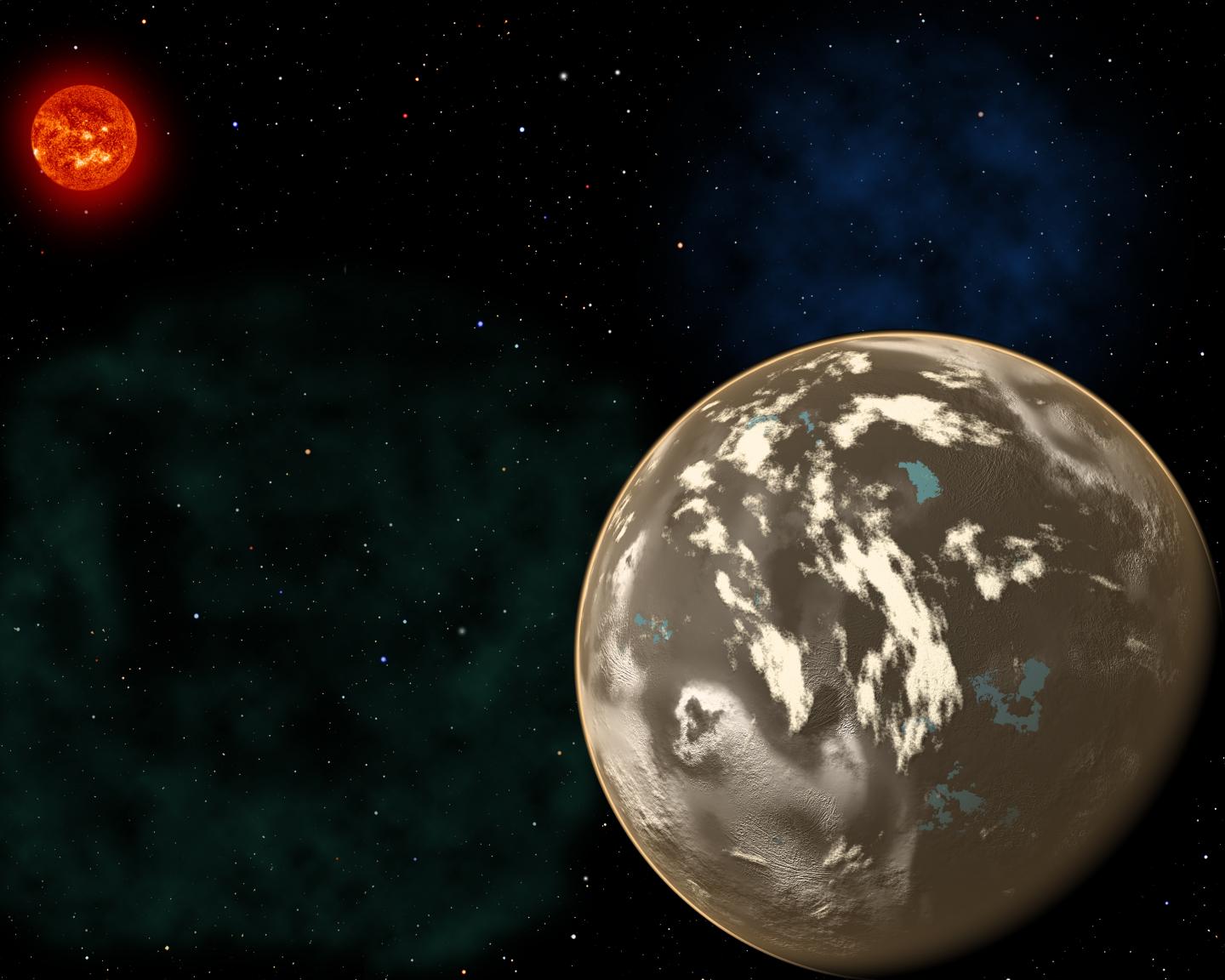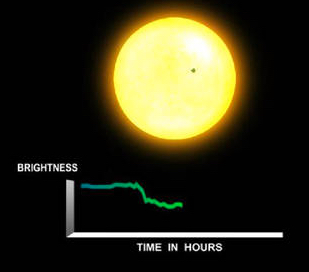Universe’s first life might have been born on diamond planets
June 7, 2016

In this artist’s conception, a carbon planet orbits a sunlike star in the early universe. Young planetary systems lacking heavy chemical elements but relatively rich in carbon could form worlds made of graphite, carbides, and diamond rather than Earth-like silicate rocks. Blue patches show where water has pooled on the planet’s surface, forming potential habitats for alien life. (credit: Christine Pulliam (CfA), Sun image: NASA/SDO)
New findings by scientists at the Harvard-Smithsonian Center for Astrophysics (CfA) suggest that planet formation in the early universe might have created carbon planets consisting of graphite, carbides, and diamond and that astronomers might find these diamond worlds by searching a rare class of stars.
“This work shows that even stars with a tiny fraction of the carbon in our solar system can host planets,” says lead author and Harvard University graduate student Natalie Mashian. “We have good reason to believe that alien life will be carbon-based, like life on Earth, so this also bodes well for the possibility of life in the early universe.”
The primordial universe consisted mostly of hydrogen and helium, and lacked chemical elements like carbon and oxygen necessary for life as we know it. Only after the first stars exploded as supernovae and seeded the second generation did planet formation and life become possible.
Clues to how life got started in the universe
Mashian and her PhD thesis advisor Avi Loeb examined a particular class of old stars known as carbon-enhanced metal-poor (CEMP) stars. These “anemic” stars contain only one hundred-thousandth as much iron as our Sun, meaning they formed before interstellar space had been widely seeded with heavy elements.
“These stars are fossils from the young universe,” explains Loeb. “By studying them, we can look at how planets, and possibly life in the universe, got started.”
CEMP stars have more carbon than would be expected, given their age. This relative abundance would influence planet formation as fluffy carbon dust grains (from supernovae) clump together to form tar-black worlds.
From a distance, these carbon planets would be difficult to tell apart from more Earth-like worlds. Their masses and physical sizes would be similar. Astronomers would have to examine their atmospheres for signs of their true nature. Gases like carbon monoxide and methane would envelop these unusual worlds.
The transit technique for detecting carbon planets

When a planet crosses in front of its star as viewed by an observer, the event is called a transit. The relative change in flux caused by a carbon-based planet transiting across its host CEMP star would range from ~0.0001% to ~0.01%.
(credit: NASA Ames)
But a dedicated search for planets around CEMP stars can be done using the transit technique, the scientists suggest. We encountered the transit technique on KurzweilAI in “How to use laser cloaking to hide Earth from remote detection by aliens” — in which we noted we two Columbia University astronomers suggested that we could cloak our Earth from aliens by shining a laser during transits so they couldn’t see the tiny giveaway changes in brightness — or that we could modify the light from our Sun during a transit to make it obviously artificial, sending a message to ET: “we’re here.”
In the new CfA paper, published in the Monthly Notices of the Royal Astronomical Society*, the scientists note that the relative change in flux caused by a carbon-based planet transiting across its host CEMP star ranges from ~0.0001% to ~0.01% — too weak to be detected by ground telescopes. That means it would require “space-based transit surveys that continuously monitor a large number of potential host stars over several years and measure their respective transit light curves.”
Fortunately, “there are a number of ongoing, planned, and proposed space missions committed to this cause,” the CfA scientists note. No word if the space-based transit surveys will also watch for artificial messages.
Headquartered in Cambridge, Mass., the Harvard-Smithsonian Center for Astrophysics (CfA) is a joint collaboration between the Smithsonian Astrophysical Observatory and the Harvard College Observatory. CfA scientists, organized into six research divisions, study the origin, evolution and ultimate fate of the universe.
* The CfA study is also available (open-access) on arXiv.
Abstract of CEMP stars: possible hosts to carbon planets in the early universe
We explore the possibility of planet formation in the carbon-rich protoplanetary disks of carbon-enhanced metal-poor (CEMP) stars, possible relics of the early Universe. The chemically anomalous abundance patterns ([C/Fe] ≥ 0.7) in this subset of low-mass stars suggest pollution by primordial core-collapsing supernovae (SNe) ejecta that are particularly rich in carbon dust grains. By comparing the dust-settling timescale in the protoplanetary disks of CEMP stars to the expected disk lifetime (assuming dissipation via photoevaporation), we determine the maximum distance rmax from the host CEMP star at which carbon-rich planetesimal formation is possible, as a function of the host star’s [C/H] abundance. We then use our linear relation between rmax and [C/H], along with the theoretical mass-radius relation derived for a solid, pure carbon planet, to characterize potential planetary transits across host CEMP stars. Given that the related transits are detectable with current and upcoming space-based transit surveys, we suggest initiating an observational program to search for carbon planets around CEMP stars in hopes of shedding light on the question of how early planetary systems may have formed after the Big Bang.